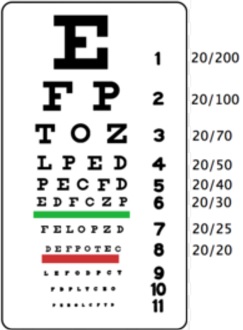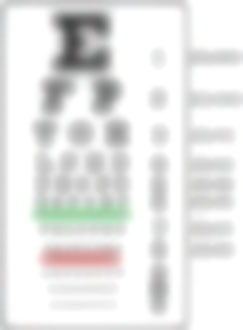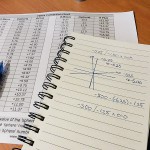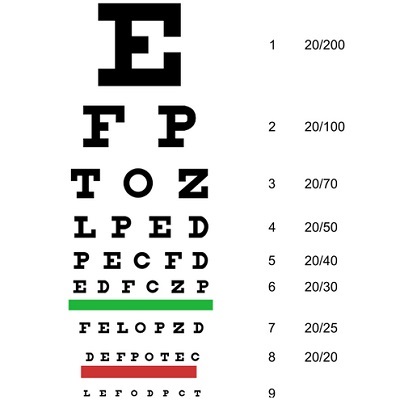The concept of being legally blind is confusing in and of itself, but it’s made even more confusing by the fact that its definition are different in different parts of the world. In this article I will explain what the legally blind requirements in the USA, Canada and the U.K are.
Let’s Define Legally Blind
Most people are familiar with the concept of being blind. In the simplest terms it means that one cannot see. But what about this term ‘legal blindness’ that everyone throws around? What exactly does it mean?
An oversimplification of what it is to be legally blind goes like this:
Being legally blind means that you have terrible vision even when you wear the most up-to-date glasses or contact lens prescription.

The key to correctly understanding what it is to be legally blind is to understand that if your vision is good, or even moderately good, when you put on glasses or contacts, you are not legally blind.
Of course, it does not suffice to use language like ‘good’, ‘moderately good’, and ‘terrible’ vision when trying to define legally blind. We have to be able to specify precise levels of vision.
Visual Acuity
Visual Acuity (VA) is what we use to measure vision. It is usually represented as a fraction.
In the U.S.A it is standard to a fraction that has a 20 on top. In Canada, the official way to measure VA is to use a fraction with a 6 on top, although many like to use the American system because it is more widely recognized.
Being told your vision is 20/20 means the same as being told your vision is 6/6. But even in Canada, everyone knows what 20/20 vision means, but 6/6 would confuse a lot of people.
The higher the number is on the bottom of the fraction, the worse the vision is. For example, a VA of 20/20 is better than a VA of 20/30, a VA of 20/30 is better than a VA of 20/40, and so on.
Your visual Acuity can be measured when you’re wearing your outdated glasses, your new glasses, your contacts, or nothing at all. In order to help specify how the visual acuity was measured, we cite different kinds of visual acuities.
Unaided Visual Acuity
Unaided Visual Acuity (UVA) refers to how well you can see when you’re not wearing any glasses or contact lenses.
Aided Visual Acuity
Aided Visual Acuity (AVA) refers to how well you can see when you are wearing your glasses or contact lenses. The AVA is not necessarily with your most up-to-date glasses or contact lenses. It can refer to your vision through your 10-year-old pair of glasses or your brand new pair.
Best Corrected Visual Acuity
The Best Corrected Visual Acuity (BCVA) is how well you can see when you’re wearing your most accurate/up-to-date prescription. The BCVA refers to your highest potential vision.
Now that we know a few more terms, let’s revise our earlier definition of what it is to be legally blind.
Being legally blind means that the BCVA of both your eyes falls below a certain threshold.
What that threshold is, depends on where you live. But before we get into specifics about thresholds in different countries, let’s discuss a different condition that can also cause you to be legally blind.
Visual Field
Your visual field refers to the range of your vision in all directions. It is often colloquially referred to as our side vision or peripheral vision.
Visual fields are measured in degrees. With both eyes open, a normal person can see almost 180 degrees horizontally and about 150 degrees vertically.
Visual Field Defects/Restrictions
You can lose parts of your visual field in a nearly infinite number of ways. Your specific visual field defect will be determined by the disease process that causes it. I.e., Glaucoma, cataracts, retinitis pigmentosa, diabetic retinopathy, etc.
Legally Blind Requirements
In the United States
The threshold of legal blindness in the U.S is 20/200. That means that your better seeing eye must have a BCVA that is equal to or worse than 20/200.
OR
A visual field that is constricted to the central 20 degrees or less (commonly referred to as ‘tunnel vision’).

For more information about the legally blind requirements in the United States, click here.
In Canada
The threshold of legal blindness in Canada is 20/200 (or 6/60). That means that your better seeing eye must have a BCVA that is equal to or worse than 20/200.
OR
A visual field that is constricted to the central 20 degrees or less (commonly referred to as ‘tunnel vision’.
For more information about the legally blind requirement in Canada, click here.
In the United Kingdom
The U.K uses different terms to define various levels of vision loss.
Severely sight impaired
- BCVA in the best eye that is worse than 6/30 – 6/60 and a full field of vision
- BCVA in the best eye that is between 6/30 and 6/60 and severe field of vision restriction
- Visual acuity of 6 / 60 or above but with a very reduced field of vision, especially if a lot of sight is missing in the lower part of the field.
Sight impaired
- BCVA in the best eye of 6/30 – 6/60 and a full field of vision.
- BCVA in the best eye of 6/24 and a moderate reduction in field of vision, or central vision loss.
- BCVA in the best eye of 6/18 or worse and a significant reduction in field of vision.
For more information about the legally blind requirements in the U.K, click here.
How Bad is 20/200 Vision?
Have you even seen this eye chart in your eye doctor’s office? If that chart were full size and you were sitting 20 feet away from it, you would have 20/200 vision if all you could see was the big E on top. If you couldn’t even see the big E, your vision would be worse than 20/200.
 |
 |
A Common Question
Many people who have elevated prescriptions want to know if they are legally blind, or at what prescription they become legally blind.
This question represents a misunderstanding of what it means to be legally blind, as it is not related to one’s prescription at all. How bad one’s vision is without his/her glasses is completely irrelevant.
Someone with no prescription for glasses or contacts can become legally blind, just as someone with -10.00 D prescription can. The question is not how high one’s prescription is, but how well that person can see when he/she is wearing up-to-date eyeglasses.
In other words, it depends on one’s BCVA and not one’s UVA.
If you just had your prescription checked, and the best that your eye doctor could get you to see through the lenses (regardless of what those lenses are), is 20/200 or less in your better seeing eye, then you’re considered legally blind.
Even if without your glasses, you can’t see a thing, but with your glasses, you can see better than 20/200, you are not considered legally blind.
Hopefully, this all makes sense now. If you still have any questions about the concept of legal blindness, feel free to ask below!




2 Responses
Melissa
What’s the difference between 6+ and 6- contact lenses, vision wise.
Julie
Hi Melissa, the difference between +6.00 and -6.00 is huge.
Any lens with a + in front of the number is a convex lens, meaning that it converges the light that passes through it. They are meant for people who are farsighted.
Any lens with a – in front of the number is a concave lens, meaning that it diverges the light that passes through it. They are meant for people who are nearsighted.
If you use a +6.00 lens when your prescription is -6.00, or vice versa, you won’t see a thing, and you’ll probably develop a headache within seconds.
The sign may seem like a minor detail, but can make all the difference in the world (vision wise), especially when you’re dealing with pretty high numbers like +/- 6.00.